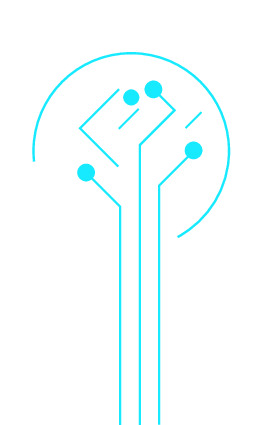|
|
|
| Module code: NE2104.NCS |
|
|
3V+2P (5 hours per week) |
|
6 |
| Semester: 1 |
| Mandatory course: yes |
Language of instruction:
English |
Assessment:
Oral exam (50%), project work (50%)
[updated 12.03.2020]
|
NE2104.NCS (P213-0141, P213-0142, P213-0189) Neural Engineering, Master, ASPO 01.04.2020
, semester 1, mandatory course
NE3103.NCS Neural Engineering, Master, SO 01.10.2025
, semester 1, mandatory course
|
75 class hours (= 56.25 clock hours) over a 15-week period.
The total student study time is 180 hours (equivalent to 6 ECTS credits).
There are therefore 123.75 hours available for class preparation and follow-up work and exam preparation.
|
Recommended prerequisites (modules):
None.
|
Recommended as prerequisite for:
|
Module coordinator:
Prof. Dr. Dr. Daniel Strauß |
Lecturer:
Prof. Dr. Dr. Daniel Strauß
[updated 12.03.2020]
|
Learning outcomes:
Learning Objectives: To develop skills for (part I) analyzing biological neural and cognitive systems and (part II) designing technical cognitive systems. Topics in part I include systems neuroscience, sensory processing and perception, and the basics of computational neuroscience. Topics in part II include pattern recognition and machine learning. This course covers the theory but also includes hands-on exercises during the lab and project work. It provides students with the ability to analyze biological cognitive systems by decoding their correlates in the central and autonomic nervous systems. Moreover, the students learn to design technical cognitive systems, especially for pattern recognition purposes in neural engineering; in this sense, part II of this course complements the feature extraction skills obtained in "Biomedical Signal & Image Processing" (NE2102) to design complete computational decision making & decision support architectures.
Participation in actual research studies and/or lab projects to complement course topics is required. That way, students receive soft skill training related to safe patient handling.
[updated 18.07.2019]
|
Module content:
Part I (Biological Systems)
1. Systems Neuroscience
1.1. The Human Nervous System
1.2. From Neurons to Circuits
1.3. Patch & Voltage Clamp Techniques
1.4. From Circuits to Systems
1.5. VSD & MEA Techniques
1.6. From Systems to Behavior
1.7. ECoG, EEG, MEG, fMRI, fNIRS Techniques
1.8. Plasticity, Learning, Memory
1.9. Executive Functions & Decision Making
1.10. Computational Models
1.11. Ethics in Neuroscience Research
2. Sensory Processing & Perception
2.1. Gestalt Psychology
2.2. Exogenous & Endogenous Processing
2.3. Models of Attention & Cognitive Effort
2.4. Models of Affective Processing
2.5. Designing Experimental Paradigms
3. Psychophysiology & Affective Computing
3.1. Intrusive and Minimal-Intrusive Psychophysiology
3.2. Non-Intrusive Psychophysiology
3.3. Affective Computing
3.4. Neuroergonomics & Human-Machine-Interaction
Part II (Technical Systems)
1. Basics of Pattern Recognition
2.1. Supervised & Unsupervised Learning
2.2. Feature Extraction Models
2.3. Discriminant Measures
2.4. Discriminant Bases
2.5. Statistical Learning Theory
2. Learning & Cognitive Machines
2.1. Classification/Regression Trees, Boosting, Random Forests
2.2. Kernel Machines for Classification/Regression
2.3. Learning as Approximation Problem
2.4. Regularization in Reproducing Kernel Hilbert Spaces
2.5. Neural Networks & Deep Learning
2.6. Reinforcement Learning
2.7. Beyond Learning
[updated 18.07.2019]
|
Teaching methods/Media:
Lecture notes, digital projector, software in the computer lab
[updated 12.03.2020]
|
Recommended or required reading:
Abeles, M.: Corticonics: Neural Circuits of the Cerebral Cortex, Cambridge University Press, 1991
Alberts, B.; Bray, D.; Lewis, J.: Molecular Biology of the Cell, Garland Science, 2002
Andreassi, John L.: Psychophysiology: Human Behavior and Physiological Response, Taylor & Francis, 2006, ISBN 978-0805849516
Bear, M.F.; Connors, B.W.; Paradiso, M.A.: Neuroscience, Lippincott Williams and Wilkins, 2001
Churchland, P.S:; Sejnowski, T.J.: The Computational Brain, MIT Press, 1992
Dayan, P.; Abbott, L.F.: Theoretical Neuroscience, MIT Press, 1992
Duda, Richard O.; Hart, Peter E.; Stock, David G.: Pattern Classification, Wiley, 2001, 2. Aufl., ISBN 978-0471056690
Eliasmith, Chris; Anderson, Charles H.: Neural Engineering - Computation, Representation, and Dynamics in Neurobiological Systems, MIT Press, 2003, ISBN 0-262-05071-4
Fletcher, R.: Practical Methods of Optimization, John Wiley & Sons, 1987
Goodfellow, Ian; Bengio, Yoshua; Courville, Aaron: Deep Learning, MIT Press, 2016
Levine, Daniel S.: Introduction to Neural and Cognitive Monitoring, Lawrence Erlbaum Associates, 2000
Malmivuo, Jaakko; Plonsey, Robert: Bioelectromagnetism, Oxford University Press, 1995
Pesenson, Misha Z.: Multiscale Analysis and Nonlinear Dynamics: From Genes to the Brain, Wiley VCH, 2013, ISBN 978-3527411986
Ripley, Brian D.: Pattern Recognition and Neural Networks, Cambridge University Press, 1996
Rosner, Jorge: Peeling the Onion: Gestalt Theory and Methodology, Gestalt-Institute of Toronto, 1990
Schölkopf, B.; Smola, A.J.: Learning with Kernels: Support vector Machinces, Regularization, Optimization and Beyond, MIT Press, 2002
Sheppard, Clinton: Tree-based Machine Learning Algorithms: Decision Trees, Random Forests, and Boosting, CreateSpace Independent Publishing Platform, 2017, ISBN 978-1975860974
Vapnik, V.N.: Statistical Learning Theory, John Wiley & Sons, 1998
Wahba, G.: Spline Models for Observational Data, SIAM, 1990
[updated 18.07.2019]
|


